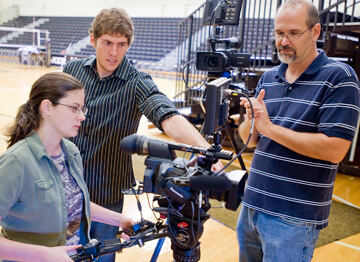Collaboration with Big Ten Network gives students experience, credits

Purdue students Emily Gray and Daniel Parker work with Rex Arends (right), director of university technical operations for BTN, during a training session at the Intercollegiate Athletics Facility. The session focused on flypacks, which are stackable, mobile cases that include all the high-tech equipment necessary for broadcasting. (Purdue University photo/Andrew Hancock)
Last year the Big Ten Network began a streaming initiative to give interested students at Big Ten universities a semester of hands-on experience with live sports broadcasting.
This year the program has expanded to a full year of live event production and has been incorporated into Purdue's curriculum.
Through a collaboration among Purdue's Hall of Music Productions, film and video studies, Intercollegiate Athletics and the Big Ten Network, students with majors or minors in film and video studies can enroll in the course and receive three college credits.
"Last year we found students who were interested in video broadcasting, but we are able to do something really special with it this year," says Bobby Chastain, manager of academic outreach and student learning for Hall of Music Productions and instructor of the course. "By taking the program into the classroom, students get to do more than film events. They learn the entire process, hold production meetings, put together a production book and gain invaluable career experience."
Ten film and video studies students and five students who will be in front of the camera will produce between 20 and 30 events, including volleyball matches, wrestling meets and three men's basketball games. Across the Big Ten Conference, students will cover about 700 events.
Cory Palm, web media specialist for Purdue sports information, says, "Last year 80 percent of student footage aired on the Big Ten Network after the live stream aired online. We had student announcers who were on TV, and some of our students were able to put portfolio tapes together from shows that aired on the Big Ten Network."
Palm says the academic atmosphere and experiential learning the students receive also allows them to try different positions within broadcasting including direction, production and filming.
Rex Arends, director of university technical operations for BTN, hosted four three-hour training sessions at Purdue to teach students about the flypacks he helped develop.
Flypacks are stackable, mobile cases that include all the high-tech equipment necessary for broadcasting. Student-produced shows stream live in high definition online at bigtennetwork.com and air later on Student U programming on the Big Ten Network.
Emily Gray, a sophomore in FVS and a student in the new course, says, "The training was almost overwhelming at first, but since everything was taught step-by-step, it went very well."
Before the student crew produced its first live broadcast, it had a practice run. Gray says, "Even though there were no major mistakes during our first volleyball game, there are areas where we can improve. The whole class worked really well together, and I think we'll make a great crew."
After last year's streaming initiative, 15 students across the conference who participated in the live broadcasts have been hired to work on BTN trucks. One student is now producing events.
Arends says, "We're 51 percent owned by the Big Ten Conference, so if we aren't giving back to or assisting in the educational aspect that is so important to these schools, then we aren't doing our job."
